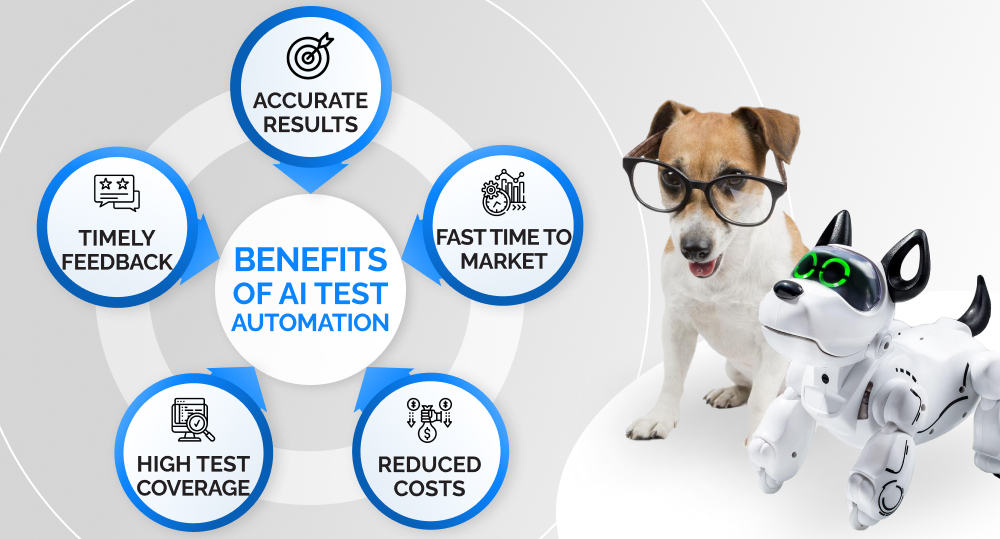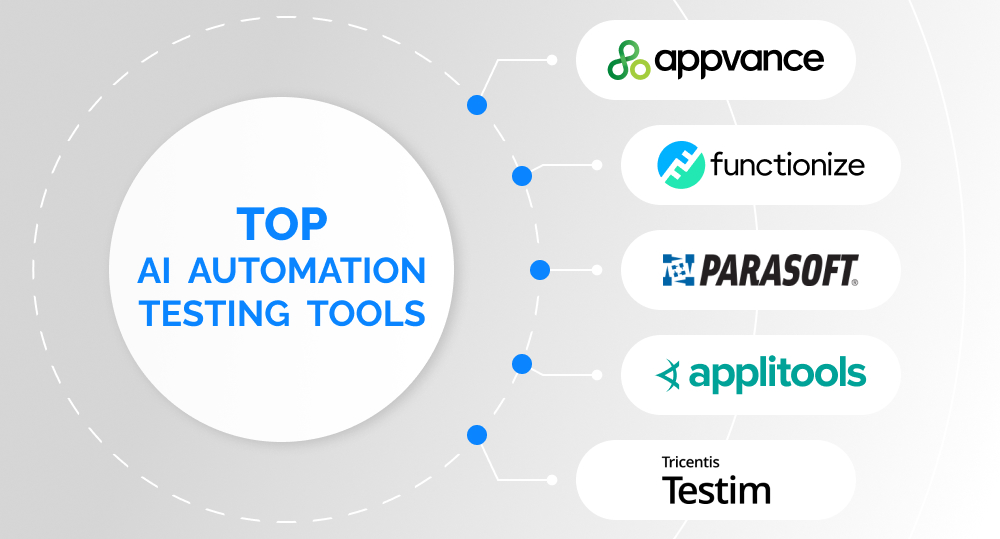How many AI testing tools do you take advantage of to enhance software quality? Or do you still think that the potential of almighty artificial intelligence is limited to creating unique artwork and pieces of content? In reality, the opportunities unleashed by AI/ML have already gone far beyond Midjourney or ChatGPT and spread to the development and testing processes.
Wanna know how to unite machine learning and test automation and benefit from using AI for QA & testing? Keep reading!
written by:
Alexey Rakitsky
Test Automation Manager
How many AI testing tools do you take advantage of to enhance software quality? Or do you still think that the potential of almighty artificial intelligence is limited to creating unique artwork and pieces of content? In reality, the opportunities unleashed by AI/ML have already gone far beyond Midjourney or ChatGPT and spread to the development and testing processes.
Contents
Automation Testing in Brief
Before diving into an enigmatic and intricate AI world, let's give a shake to your memory and recall the basic concepts of automated software testing.
Key Idea
When it comes to product testing, engineers take all means to ensure thorough software analysis and excellent outcomes. Testing specialists manually create tests and hunt for bugs, while quality assurance (QA) experts do the utmost to boost the efficiency and security of the entire development process.
Still, although manual testing comes in handy when you need to assess app features and behavior from a user's perspective, it takes a lot of time (35% of a test cycle). And so does manual QA.
And that's when skilled automation engineers rush to the rescue. By developing automated tools and strategies, these tech-savvy specialists eliminate the need to create and run multiple test cases and therefore optimize the testing process.
Impact on the Testing Process
A test automation suite opens up multiple opportunities, such as:
- Extended test coverage;
- A reduced number of unintentional human errors;
- Lowered risk of test failures;
- Reusability of test cases;
- Budget saving;
- More structured test results;
- A simplified test creation process;
- Automated CI/CD.
No wonder most IT companies spend 30 to 50% of their QA resources on automated testing infrastructure and workforce.
At the same time, it's essential to understand that automated functional UI tests are not a silver bullet. They are just complementary tools designed to simplify and enhance manual analysis.
Automated Testing Lifecycle
To better understand the intricacies of an automated testing process, let's analyze its major stages.
- Engineers assess the scope of work, i.e., define the processes that should be automated, decide on the number of specialists, and estimate costs.
- They decide on the tools capable to answer project requirements.
- A testing strategy is elaborated.
- The specialists set up the environment for tests running.
- Test scripts are created and executed under various conditions. If a bug pops up, the engineers make a report.
- After analyzing all the results, the team pools efforts around further strategy elaboration. Also, test maintenance is implemented to ensure quality automation.
What Really Is AI?
Now that all the test automation basics are revised, it's time to discuss the potential of artificial intelligence (AI).
Although in the eyes of many people, AI looks like a cyborg or a multi-functional robot, such perception is a way far from reality. Artificial intelligence is just a booming technology (today, the global AI market has surpassed $142.3 billion) that tries to imitate the human mind's capabilities.
At the same time, some users keep mixing up such notions as AI, machine learning, and deep learning. To finally get all the ducks in a row and stay abreast with innovation, make use of the following table.
Deep Learning
Machine Learning
Artificial Intelligence
Definition
A method of teaching computers to recognize and process data patterns
A method of teaching computers to learn from the data obtained through algorithms
A method of teaching computers to simulate human intelligence
Approach
Learns from algorithms based on artificial neural networks that mimic the human brain
Employs algorithms to analyze data and make predictions
Learns from algorithms and huge amounts of data
Aim
Creation of neural networks capable to analyze data patterns
Solving problems with the help of data obtained through algorithms
Developing the ability to imitate such parts of human intelligence as visual perception, speech recognition, decision-making, and translation
Data
Can work with both structured and unstructured data
Works with structured data
Can work with both structured and unstructured data
Learning
Can learn and evolve on its own
Requires human control to enhance performance
Can learn and evolve on its own but still requires human intervention
5 Unbeatable Reasons to Use AI for Test Automation
Have you heard that 48% of users are unlikely to download an app again if its performance is poor and functionality won’t work properly? Such disappointing statistics make test engineers keep searching for new ways of software analysis perfection.
In the 2010s, we witnessed the emergence of AI/ML testing tools in the digital field. Their primary goal was to enhance automated testing capabilities and explore their full potential. Although we are currently experiencing the peak of the AI hype cycle and its impact on the software development industry is not yet 100% understood, we are beginning to reap the first positive outcomes.
#1. Boosted Accuracy
Enriched with artificial intelligence and machine learning, automated testing can easily identify visual bugs and error trends and enhance the quality of your software.
#2. Accelerated Product Delivery
Automated maintenance is another tangible reason to use AI for testing. Since tests have to be repeated and corrected in compliance with each new change in the source code, it makes sense to automate the process with AI and machine learning algorithms. In this way, not only do you take the load off testers, but also boost the time to market.
#3. Reduced Costs
To cut expenses wisely, you may also apply the power of breakthrough technologies to QA and test automation. AI-enabled tools free engineers from repetitive tasks, allowing them to concentrate on more complicated issues. As a result, you can downsize the staff and attendant costs.
#4. Better Test Coverage
Unlike traditional tools for test automation, their AI-powered counterparts prove to be even more efficient, when it comes to the depth and scope of software analysis.
#5. Timely Feedback
The earlier errors are identified, the better. And AI-driven testing, as well as AI QA automation, unlock this opportunity. By suggesting readable recommendations at the earliest stages possible, AI-based automation testing tools save the efforts of digital transformation teams.
AI Test Automation: Tools & Use Cases
Where to Apply AI-Driven Test Automation?
Ready to make the next step towards digital transformation and upgrade the testing process? Here are several ways you can use AI for automation testing.
- It is possible to employ AI-based image recognition techniques to create UI tests capable to assess visual aspects and detect interface bugs.
- With AI tools, it becomes possible to automate API testing and streamline unit tests.
- One more use case of AI in test automation (example: Applitools) is connected with regression testing.
- To accelerate the self-healing process and reduce manual operations, you may also take advantage of AI testing tools.
- And last but not least: the ability to automatically adjust test scripts to code changes makes AI-powered tools a tangible part of the test maintenance process.
Best AI Automation Testing Tools
Although AI test automation is a relatively new industry, it can already boast an impressive number of tools. Below, you will find our shortlist.
#1. Appvance
With this innovative tool, you may effectively implement load, performance, and security testing, as well as thoroughly analyze APIs and UI.
#2. Functionize
If you are looking for a cross-browser solution (for both desktop and mobile browsers) that can conduct auto-healing tests, take advantage of Functionize.
#3. Parasoft
Parasoft is an excellent choice for those who seek a reliable, smart tool for API testing and test maintenance automation.
#4. Applitools
Hunting for the one-size-fits-all solution? Take a look at Applitools — the almighty automation tool that offers even AI bot testing and codeless testing.
#5. Testim.io
This high-end test automation tool is really good at functional testing. Besides, it helps engineers to increase test coverage and get rid of flaky tests that burn out resources.
Key Takeaways
Before you leave this page, let's systematize the insights mentioned above in the FAQ manner.
#1. What Is AI Automation Testing?
Test automation with AI is a revolutionary step in the QA & testing industry that simplifies the engineers' life and extends their capabilities. With AI-based software testing tools, not only can you enhance the work of automation technologies, but also accelerate the creation of test scripts and reports.
#2. How Is AI Used in Test Automation?
It's possible to employ AI software testing tools for visual testing, API testing, auto-healing and unit tests, test maintenance, and other processes. Besides, you can use AI in QA automation and continuous testing.
#3. What Are the Benefits of AI in Automation Testing?
When leveraging AI-based test automation tools, you may enhance the accuracy of the existing tests, increase the amount of code executed during each test suite, minimize hiring costs, streamline repetitive tasks, and boost the time to market.
#4. Can AI Replace Automation Testing?
AI-powered tools do optimize the test automation life-cycle. At the same time, these are just tools, not futuristic robots. They simply minimize engineers' testing efforts and still require human intervention and control.
#5. Which Tool Is Mostly Used in Automation Testing?
Among the most widely-used AI-based testing tools you may find Functionize, Sofy.ai, Mabl, Parasoft, Testim.io, Applitools, and Appvance. Also, Selenium AI testing is gaining momentum today, as it allows engineers to meticulously test web applications.
#6. Which Tool Is the Best for Automation Testing?
When selecting AI tools for testing, keep in mind the final goals, test types, and the scope of work. Still, many experts consider Parasoft, Functionize, Mabl, Applitools, and Appvance one of the most efficient.
Hunting for the rock-star experts capable to assess the state of your product and elaborate a proper testing strategy? Contact us, and we will do our best to boost the security and performance of your solution.

Contacts
Feel free to get in touch with us! Use this contact form for an ASAP response.
Call us at +44 151 528 8015
E-mail us at request@qulix.com









